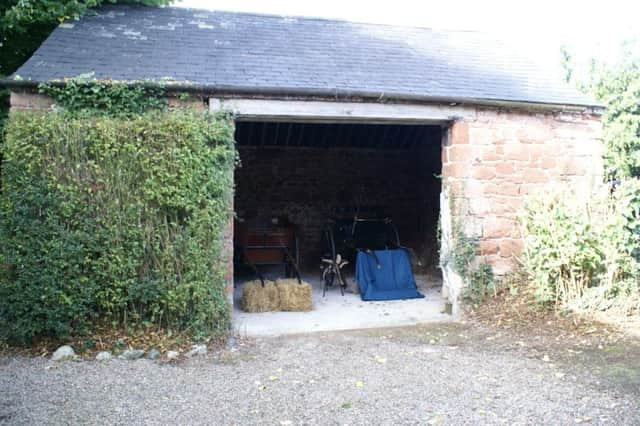Roamer: Flour and animal-feed bags under the coach house rafters


If anyone mentioned steam-trains, Belfast-built ships or vintage cars in their letters to Roamer, there was generally a follow-up of memories from all over Northern Ireland.
Probably the best example was Moneymore reader Iris Stewart’s reference to Robert Morton’s Early Riser Flour Bags.
Advertisement
Hide AdAdvertisement
Hide AdIris was “thinking back to the 1950s” when she penned the seemingly innocuous reflection - “I am sure that some of your readers remember ‘the flour bags’.”
Roamer didn’t anticipate the number of people who fondly recalled the bags, each bag printed with the Morton company motif - a bird, which presumably caught the early worm!
But I should have expected the large response from News Letter readers.
Iris’s apostrophes around ‘the flour bags’ emphasised their significant role in days of yore, and her usage of the definite article stressed the bags’ important role in our social and domestic history!
Advertisement
Hide AdAdvertisement
Hide Ad“My mother would have used a primus stove outside in our backyard,” Iris recounted “and a tin bath was then put on top of it, filled with water (from the pump!). Soap would have been added. In went the flour bags, which were boiled and boiled for hours to remove the motif - ‘Early Rise’ flour with a bird on it.”
“As children we were well warned not to go near this while it was boiling, and we didn’t!”
Iris continued “and when the bags were ready and there was only a faint trace of the motif left, they were hung on the washing line - as white as snow!”
Her mother used the flour bags as tea towels “but some people sewed a few of them together and used them as sheets” she wrote, ending her letter with the observation “such a change in washing methods now - our washing machines are so handy, but I can still recall the lines of flour bags back then.”
Advertisement
Hide AdAdvertisement
Hide AdSo did many other readers who sent in their memories of recycled flour bags, mostly as clothes, table cloths, curtains, aprons and pillow cases. They were even decorated or embroidered for extra effect!
Someone forwarded ‘A Bag of Tricks for Home Sewing’ - the headline on a WWII newspaper article offering patterns and styles for all sorts of bags, including animal foodstuffs.
Roamer was told “various slogans were used in the war - ‘Dig for Victory’ was probably the best known but another one was ‘Make do and Mend’”
“Young folk of today’s ‘throwaway society’ will be totally unable to comprehend the shortages of that time or, indeed, the poverty of earlier times,” a reader philosophised. “Clothes and household linen were rationed. People did not have wardrobes full of clothes or hot presses full of bed linen.”
Advertisement
Hide AdAdvertisement
Hide Ad“The sheets on my bed in the 1950s had a faint trace of printing on them which said ‘Early Riser’” someone wrote nostalgically, explaining a procedure that was carried out on unsuspecting flour bags by housewives all over Britain - “the seams were unpicked and then sewn together to form a rectangle.”
More than a year after Iris Stewart triggered our initial interest, Roamer has encountered yet another very innovative use for the bags in the past.
And not just early bird bags, but half a dozen other flour and animal-feed bags too.
Recent reports on this page about the renovation and restoration of Grange Quaker Meeting House near Dungannon included some historical details: there’s an old meeting house on the site dating from 1756 but the ‘new’ one that’s been renovated was built in 1816.
Advertisement
Hide AdAdvertisement
Hide AdThe adjacent caretaker’s house was built in 1812 and the stable and coach house were added in 1837.
The latter was used by well-heeled worshippers with the financial means to own and maintain coaches and horses.
The coach house had a thatch at first, later replaced with slates, and the timber beams and rafters proved very popular for nesting birds!
But the flocks of feathered tenants deposited their droppings on the coaches below, which doubtlessly irritated their owners!
Advertisement
Hide AdAdvertisement
Hide AdSo flour bags and animal-feed bags were sewn together into a large sheet which was draped under the rafters and the coaches, and later the cars, were shiny and clean when their owners emerged from Sunday morning meetings.
The bags are still there, sporting a variety of brands, though curiously, none are Robert Morton’s Early Riser Flour. Perhaps that’s because Morton’s began as a brewery sometime around the early 1830s, and Quakers were never particularly prone to enjoying a tipple!
Grange’s old coach house is draped with bags bearing all sorts of logos and motifs, with names like Red Seal, Hamilton, Blacks, Isaac Andrews Pig Feed and James Neill Reliable Flour.
Any more uses for these old bags will be appreciated via Roamer’s mailbox, meanwhile here’s a final note from a lady reader that’s been waiting to be shared since the last time we discussed bag-recycling.
“I was always so excited to get to wear my new clothes to school until one day a little chum pointed at my latest outfit and said ‘my daddy buys cow feed in a sack that looks just like your dress!’”